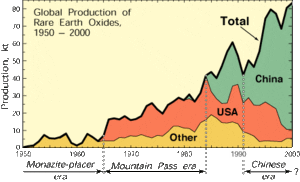
A supply of clean, affordable energy depends on little-known substances
There’s one problem with the silicon age: its magic depends on elements that are far scarcer than beach sand. Some aren’t merely in limited supply: many people have never even heard of them. And yet those elements have become essential to the green economy. Alien-sounding elements such as yttrium, neodymium, europium, terbium and dysprosium are key components of energy-saving lights, powerful permanent magnets and other technologies. And then there are gallium, indium and tellurium, which create the thin-film photovoltaics needed in solar panels. The U.S. Department of Energy now counts those first five elements as “critical materials” crucial to new technology but whose supply is at risk of disruption. The department’s experts are closely monitoring global production of the last three and likewise the lithium that provides batteries for pocket flashlights and hybrid cars.
Earlier this year the DoE took a major step by launching the Critical Materials Institute, a $120-million program to avert a supply shortage. Led by the Ames Laboratory in Iowa, with backing from 17 other government laboratories, universities and industry partners, the institute represents a welcome investment in new research. Unfortunately—like the original Manhattan Project—the program is driven more by the threat of international conflict than by ideals of scientific cooperation. The appropriation made it through Congress almost certainly because of legislators’ fear of China’s dominance in many critical elements and Bolivia’s ambition to become “the Saudi Arabia of lithium.”
The worries are probably inevitable. China—historically a prickly partner at best to the U.S.—effectively has much of the world’s critical-materials market at its mercy. Take the rare earth elements neodymium, europium, terbium and dysprosium. Despite their name, rare earths are many times more common than gold or platinum and can be found in deposits around the world. In recent years, however, cheap labor and lax environmental regulation have enabled China to corner the global market, mining and refining well over 90 percent of rare earths.
At the same time, China has consistently fallen short of its own production quotas. In 2012 the U.S., the European Union and Japan, suspecting China was manipulating the market, filed a formal complaint with the World Trade Organization (WTO). China argues that production cutbacks were necessary for environmental cleanup. At press time, a preliminary ruling in October 2013 against China will likely be appealed. Meanwhile Japan has announced discovery of vast undersea deposits of rare earths, and the Americans, among others, are working to restart their own disused facilities. The shortages won’t last.
Bolivia’s lithium is a different story. The impoverished, landlocked country needs no artificial shortages to boost the market. As the lightest metal, lithium has unmatched ability to form compounds that can store electricity in a minimal weight and volume. At least half the world’s known reserves are located in a relatively small stretch of the Andes Mountains, where Bolivia and Argentina share a border with Chile.
There’s more at stake here than fancy gadgets for the rich.
The Latest on: Rare earths
[google_news title=”” keyword=”Rare earths” num_posts=”10″ blurb_length=”0″ show_thumb=”left”]
via Google News
The Latest on: Rare earths
- Lynas Rare Earths: The Storm Is Not Over, Yeton April 27, 2024 at 6:32 am
Discover Lynas Rare Earths' disappointing Q3 results, declining prices, inventory management, and progress on projects. Read the article for more details.
- The Dirtiest Side of EVs: Rare Earths and Conflict Metalson April 26, 2024 at 2:43 pm
"Typical mining operations for rare earth mines vary from hard rock to heavy-mineral sands and ionic adsorption clay operations," de Jonge said. "For hard rock assets (the most common), metallurgy is ...
- ASM secures EDC support for Dubbo rare earths projecton April 26, 2024 at 5:09 am
The funding will support the construction and execution phase of its Dubbo rare earths and critical minerals project in New South Wales, Australia. This interest by EDC is a result of ongoing ...
- Moriah ore tailings pile could be rare earths sourceon April 25, 2024 at 9:00 pm
MORIAH — Phoenix Tailings has started a pilot program to recover rare earths from the old iron ore tailings pile in Moriah.
- Rare Earths Reserves: Top 8 Countries (Updated 2024)on April 24, 2024 at 1:55 pm
Rare earths prices soared to their highest level in 20 months, according to OilPrice.com, in early Q3 2023 coinciding with a temporary production halt in Myanmar, which accounted for 38 percent of ...
- NASA video shows the sun just blasted out 4 eruptions at the same time. The rare event may have sent plasma hurtling toward Earth.on April 24, 2024 at 9:52 am
The sun is near the peak of its power, which may explain four solar flares erupting at once. They're no danger to Earth.
- Lynas Rare Earths' revenue slumps, misses expectationson April 23, 2024 at 5:47 pm
Australian miner Lynas posted a slump in third-quarter sales revenue on Wednesday, missing analyst expectations on the back of a plunge in prices for rare earths, while it flagged higher costs at a ...
- 4 solar flares simultaneously erupt from the sun in rare 'super' explosion — and Earth could be hit by the fallouton April 23, 2024 at 10:11 am
In the early hours of Tuesday (April 23), quadruple solar flares near-simultaneously exploded from across the sun's surface, and there's a good chance that one of these outbursts launched a solar ...
- 1 Top-Rated Rare Earth Stock to Scoop Up Nowon April 23, 2024 at 6:02 am
Uranium (UXM24) prices soared earlier this year, after Kazatomprom - the world's biggest uranium producer \- warned of its inability to reach production targets for the next two years. Reports suggest ...
- One problem for renewables: Not enough rare earths. One solution: recycling. But there’s a hitch.on April 22, 2024 at 3:00 am
A huge amount of the metals and rare earths needed to build solar panels, wind turbines, and electric vehicles may be sitting in the trash heap. Consumers throw out 62 million metric tons of ...
via Bing News










